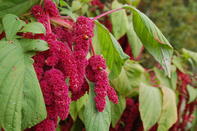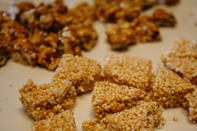Amaranth Seeds
Amaranth seed was a staple grain in Mexico, Guatemala and Peru thousands of years ago and was probably as popular as corn. The seeds were mixed with honey to form cakes to use in religious ceremonies and then eaten.

The leaves are also edible and highly nutritious. Amaranth seeds can be sprouted. Rinse one tablespoon of seed and in a canning jar with a perforated lid. Rinse every eight hours. Use sprouted seeds on sandwiches and in salads.
Protein-rich amaranth seeds are prepared on the stove or in the microwave. Use one cup of amaranth seeds for three cups of boiling salted water, apple juice or chicken broth.
Bring to a boil and then simmer for about 20 minutes until water is absorbed. If left too long, it can become sticky. Amaranth's gelatinous quality makes it useful to thicken soup.
The seeds can also be roasted, popped (do not use oil) or added to other dishes such as rice to give a nutty sweetness. Amaranth is different to other whole grains. It never loses its crunch completely, but rather softens on the inside while the grains seem to pop between your teeth.
Nutritional Value of Amaranth

According to the World Grains Council, amaranth is also the only grain documented to contain Vitamin C. In addition, it contains about 14% protein and is rich in amino acids, including lysine.
Amaranth flour is gluten-free and will not work as a replacement flour in breads - replace about 30% of the flour with amaranth flour to reduce the gluten in the final bread. Amaranth flour can be used in pancakes, biscuits and pastas.
Amaranth Leaves
Amaranth leaves are harvested by hand and are best eaten fresh - the same day. It can also be boiled in salted water (like spinach) and served with a sauce of tomatoes and onion or potatoes and onion. The fresh leaves can be added to salads or sauteed and added to other cooked vegetables such as broccoli and onions.
Amaranth tea (1 cup of boiling water on a quarter cup of fresh leaves) may treat anaemia, chronic fatigue, diarrhoea as well as coughs and heavy menstrual bleeding. Using a cooled tea as a lotion can relieve itchy burning skin and can be used to clean wounds.
Micronutrients in amaranth include carotene, vitamins A, iron, magnesium, phosphorus, potassium and calcium. Red-leaved amaranths are also rich in anthocyanins - pigments high in antioxidant properties.
By Marinda Louw